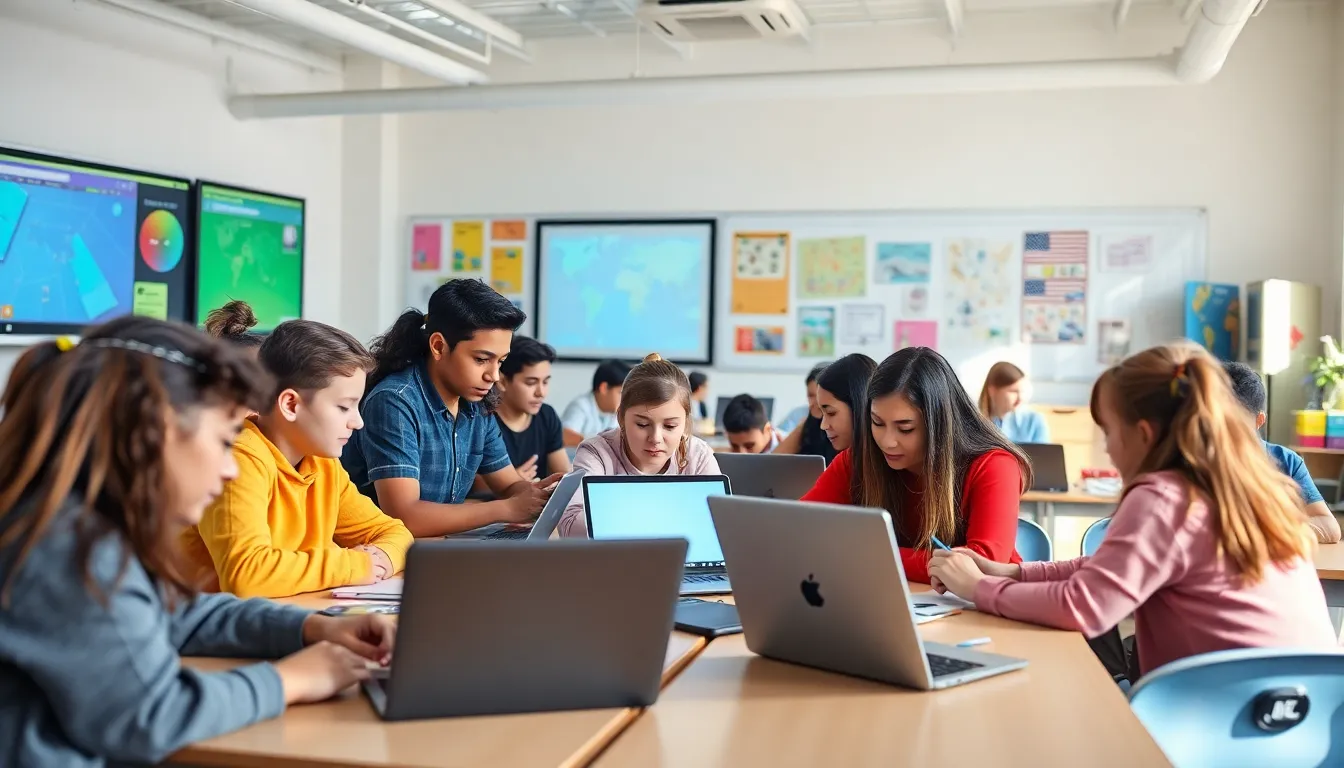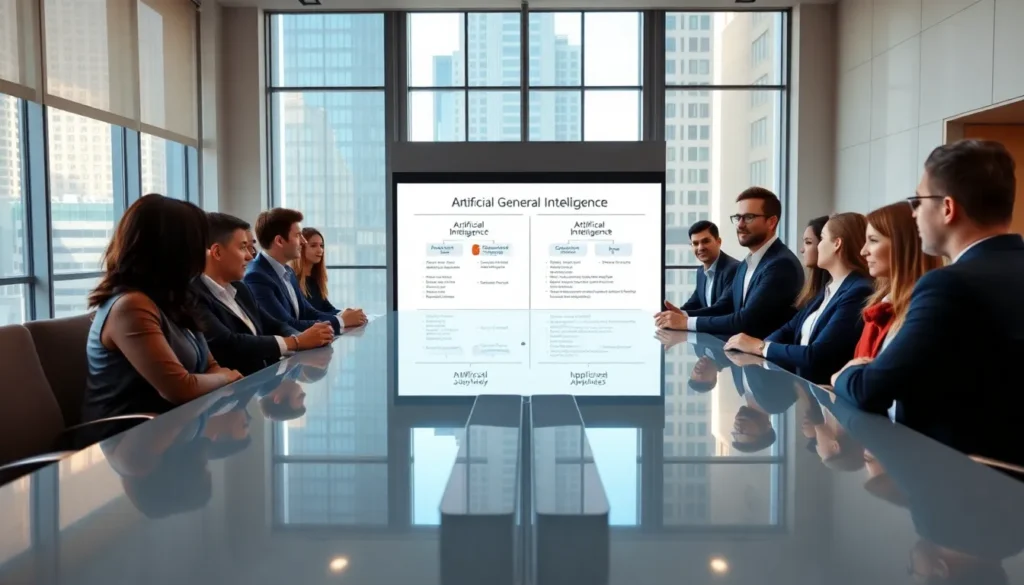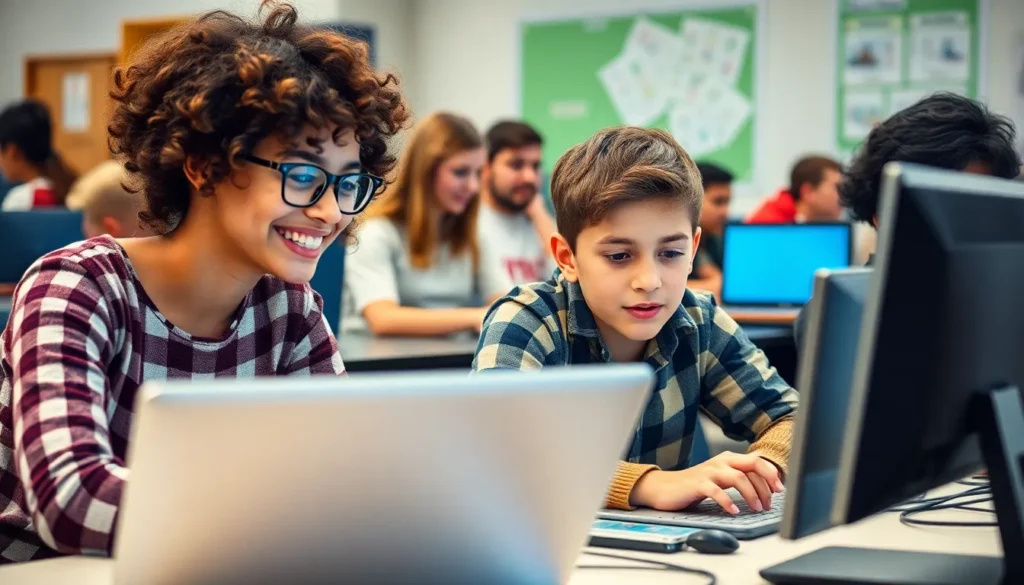Table of Contents
ToggleIn today’s fast-paced world, the digital classroom has transformed the way students learn and teachers instruct. With the rise of technology, traditional educational methods are evolving, making way for innovative approaches that enhance engagement and accessibility. Students can now connect with their peers and educators from anywhere, breaking down geographical barriers and opening up new opportunities for collaboration.
As digital tools become integral to the learning experience, educators are discovering the potential of interactive platforms, multimedia resources, and online assessments. This shift not only fosters a more personalized learning environment but also equips students with essential skills for the future. Embracing the digital classroom is no longer just an option; it’s a necessity for preparing learners to thrive in an increasingly digital world.
Overview of Digital Classrooms
Digital classrooms integrate technology into educational environments, transforming traditional learning approaches. They allow educators to leverage various tools that enhance instruction and engage students. Key features of a digital classroom include:
- Interactive Platforms: These platforms facilitate real-time communication and collaboration among students and teachers, fostering a dynamic learning experience.
- Multimedia Resources: Incorporating videos, podcasts, and interactive simulations enriches content delivery, catering to different learning styles.
- Online Assessments: Digital assessments enable instant feedback, allowing educators to monitor student progress and adjust teaching methods accordingly.
- Resource Accessibility: Students access educational materials anytime, promoting self-paced learning and flexibility.
- Collaboration Tools: Tools such as discussion forums and group project spaces encourage teamwork, teaching essential skills for the modern workforce.
Digital classrooms exemplify the shift towards personalized education, positioning learners to thrive in a technology-driven world.
Benefits of Digital Classrooms

Digital classrooms offer numerous advantages that significantly improve educational experiences. They foster engagement, adaptability, and create inclusive environments for diverse learners.
Enhanced Learning Experience
Digital classrooms enhance the learning experience through interactive platforms. Students access multimedia resources like videos, simulations, and virtual labs, catering to various learning preferences. Real-time feedback from online assessments enables students to track progress instantly, promoting a more personalized learning path. Collaborative tools allow for group work, encouraging communication and teamwork among peers, which helps in developing critical thinking skills.
Flexibility and Accessibility
Digital classrooms provide flexibility in learning, allowing students to learn at their own pace. They eliminate geographical barriers, enabling access to high-quality educational content from anywhere in the world. Students can choose their study times and formats, fitting education into their lifestyles or obligations. Additionally, digital classrooms often use adaptive learning technologies, ensuring that resources are tailored to meet individual needs, further enhancing accessibility for students with different learning requirements.
Challenges of Digital Classrooms
Digital classrooms present unique challenges that can hinder their effectiveness. Understanding these obstacles is crucial for creating an optimal learning environment.
Technical Issues
Technical issues frequently disrupt the digital classroom experience. Connectivity problems can impede access to online resources, leading to interruptions during lessons. Software glitches may prevent seamless interaction with educational platforms. Inadequate hardware, such as outdated computers or insufficient bandwidth, can limit participation in multimedia activities. Institutions often struggle with cybersecurity threats, which can compromise both student data and the integrity of their learning environments.
Student Engagement
Maintaining student engagement in digital classrooms poses a significant challenge. Virtual platforms can create distractions, making it difficult for students to stay focused. The lack of physical presence may diminish personal connections between classmates and instructors, reducing motivation. Students may also exhibit lower participation levels in discussions and collaborative projects compared to face-to-face settings. Asynchronous formats can lead to feelings of isolation, impacting overall learning outcomes. It’s essential to implement interactive features and engaging content to enhance student participation and connection in the digital learning sphere.
Tools and Technologies for Digital Classrooms
Digital classrooms utilize a variety of tools and technologies that enhance the learning experience and facilitate effective teaching. These resources foster collaboration, accessibility, and engagement among students and educators.
Learning Management Systems
Learning Management Systems (LMS) serve as central platforms for delivering educational content and managing student progress. Popular LMS options include:
- Moodle: Offers customizable features for course creation and student tracking.
- Canvas: Provides user-friendly navigation and integration with various educational tools.
- Blackboard: Supports extensive course management and assessment capabilities.
LMS allows educators to disseminate resources, assign tasks, and monitor student performance through detailed analytics. With mobile compatibility, students access materials from anywhere, enhancing flexibility in learning.
Interactive Tools
Interactive tools enhance student engagement by promoting active participation during lessons. Key tools include:
- Kahoot!: Enables educators to create quizzes and polls that students can respond to in real-time.
- Nearpod: Offers interactive presentations where students can engage with content through questions, polls, and collaborative activities.
- Padlet: Facilitates brainstorming and collaboration through a digital wall where students can post ideas, comments, or materials.
These tools support diverse learning styles, allowing students to interact with content more dynamically and collaboratively. By fostering a participatory environment, they address the challenges of maintaining engagement in virtual settings.
Future Trends in Digital Classrooms
Digital classrooms continue evolving, incorporating advanced technologies and pedagogical strategies.
- Artificial Intelligence: AI personalizes learning experiences by adapting content to student needs. AI tools offer tailored recommendations and track progress, enhancing instructional effectiveness.
- Virtual and Augmented Reality: VR and AR create immersive learning environments that enhance engagement and comprehension. Students explore concepts in 3D, making abstract ideas tangible and stimulating interest in subjects.
- Gamification: Gamification employs game elements to motivate students and make learning enjoyable. Incorporating challenges, rewards, and competitive elements boosts student participation and retention.
- Collaborative Learning Platforms: Enhanced collaboration tools facilitate teamwork across geographical boundaries. Platforms like Microsoft Teams and Slack support project-based learning, encouraging communication and collaboration among students.
- Data Analytics: Learning analytics provides insights into student performance and learning patterns. Educators utilize data to identify areas for improvement and tailor approaches, fostering a more targeted learning experience.
- Flipped Classroom Models: Flipped classrooms enable students to access instructional content at home and engage in hands-on activities during class time. This approach promotes critical thinking and collaboration, allowing for deeper exploration of topics.
- Mobile Learning: Mobile devices bolster learning flexibility, allowing students to access materials anytime, anywhere. As technology becomes more integrated into everyday life, mobile learning ensures continuity and accessibility.
- Focus on Digital Citizenship: With increased online engagement, teaching digital citizenship becomes imperative. Programs address online safety, digital footprints, and ethical behavior, preparing students for responsible internet use.
- Increased Use of Cloud Technology: Cloud-based applications enhance accessibility and collaboration. Students and teachers access resources seamlessly, promoting a shared learning experience.
- Emphasis on Student Well-Being: Future digital classrooms prioritize mental health and well-being, integrating social-emotional learning into curriculum design. Programs support stress management and emotional intelligence, fostering a holistic educational approach.
The continuous integration of these trends into digital classrooms enhances the learning experience, making education more interactive, inclusive, and effective for all students.
The digital classroom represents a significant leap forward in education. It offers an array of tools and technologies that enhance learning experiences while addressing diverse student needs. By embracing this innovative approach educators can create engaging and inclusive environments that prepare students for the future.
Challenges remain but the potential benefits far outweigh the drawbacks. As technology continues to evolve the digital classroom will likely become even more integral to educational practices. Adopting these advancements not only fosters collaboration and critical thinking but also equips students with essential skills for a rapidly changing world. The journey toward a fully realized digital classroom is just beginning and its impact on education is poised to be profound.







